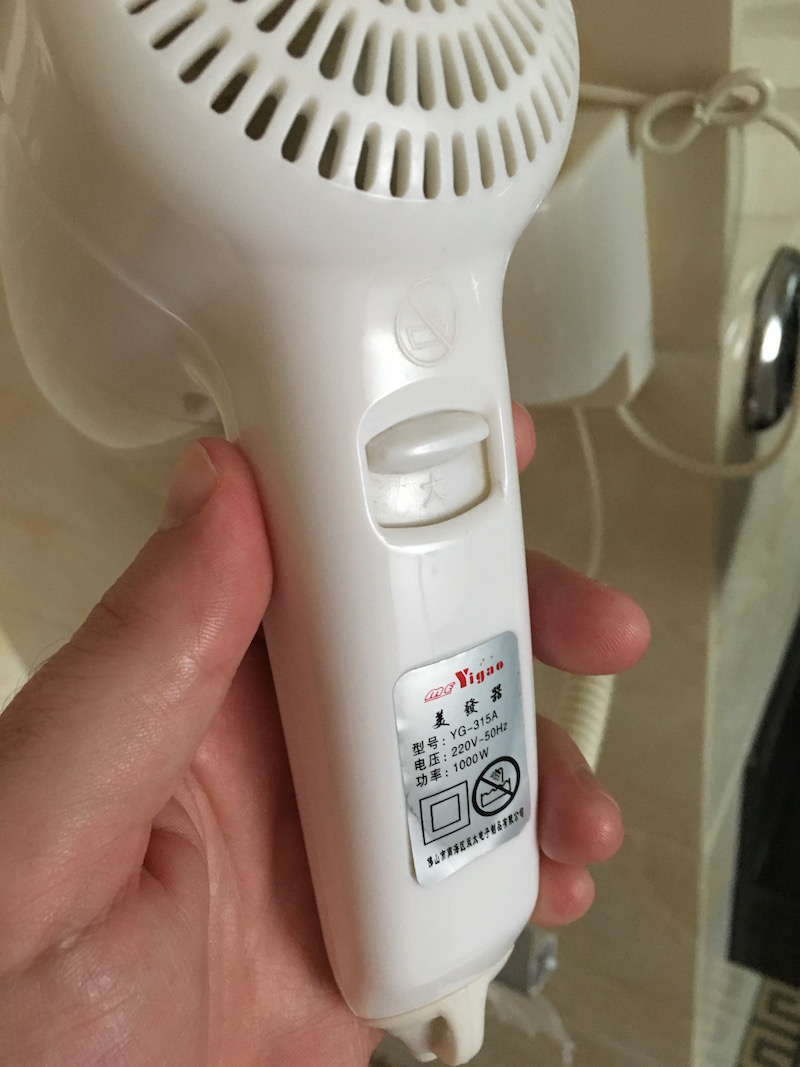Character conversion blues
« previous post | next post »
Mike Miller writes:
I recently stayed in a hotel in a smaller city in Shandong and was surprised to see what they are calling a hair dryer these days.
Here's a photograph that Mike sent along:
Several things to note.
First, the brand name is in Pinyin, with no Chinese characters to match.
Second, they use traditional characters to write the name of the product, probably to make it seem more high class, whereas it actually looks rather cheesy.
Third, they must originally have written the name of the product in simplified characters, then incorrectly converted to traditional.
They started with simplified:
měifà qì 美发器 ("beautiful hair implement")
then converted to traditional:
měifā qì 美發器 ("beautiful emit implement")
whereas the correct traditional should have been:
měifà qì 美髮器 ("beautiful hair implement").
Fourth, simplified 发 has two tones, first tone fā when it means "emit; send off / out; transmit; issue; release; etc." = traditional 發, and fourth tone fà when it means "hair" = 髮.
Fifth, they use a fancy form of měi 美 ("beautiful"), 羙, in a vain attempt to prettify their product.
Sixth, both the simplified and traditional character sets use the traditional form for qì 器 ("implement; utensil; device; capacity"), whereas modern Japanese uses the simplified form 器, which has two pronunciations:
a. utsuwa うつわ ("bowl; vessel; container; ability; capacity; calibre; caliber")
b. ki き ("device; instrument; vessel; container")
Unless you have very good eyes, you most likely won't even notice the difference.
Seventh, whoops! Almost forgot. The name they use for "hair dryer", měifà qì 美发器, is strange too. Chinese usually call it chuīfēng jī 吹风机 (lit., "blow wind machine") or diàn chuīfēng 电吹风 (lit., "electric blow wind").
[Thanks to Jing Wen, Melvin Lee, Fangyi Cheng, and Rebecca Fu]

Rosie Redfield said,
July 5, 2016 @ 2:22 pm
Readinging 'what they are calling a hair dryer' led me to expect a photo of something that wasn't a hair dryer but was called one, not of a hair dryer that was being called something else.
WSM said,
July 5, 2016 @ 4:11 pm
This sort of thing makes reading Classical Chinese in simplified characters extra fun – multiple-use characters (假借字) are enough of a problem already without having to worry about how to interpret things like 发.
I'm also really surprised to learn that 髮 is supposed to be read 4th tone in the Mainland! I learned it as fa3, perhaps due to Taiwanese teachers (it seems to be a Taiwan thing: Mainland pronunciation http://v.youku.com/v_show/id_XMTI3Mjk5ODE4NA versus Taiwanese pronunciation in https://www.youtube.com/watch?v=JGyDXvtc-XA 0:12-0:13 ; sorry about the awkward commercials), and none of my friends have ever noticed/bothered to correct me. It's kind of strange that this 4th tone to 3rd tone migration is the exact opposite of what seems to have happened with fa3 法 as in 法國: i.e. Taiwan-accented Mandarin turns the 法 in France/法国 from 3rd tone (Mainland) to 4th tone (I believe that only happens, for whatever reason, when it means "France").
Thanks to the lack of tonal information in the characters themselves I've made it through years without ever realizing the discrepancy in such a basic word…
Bruce Rusk said,
July 5, 2016 @ 6:38 pm
I wonder whether the use of the form 羙 for mei may not just be prettification but also chosen for the presence of the fire element on the bottom of the character–appropriate for this particular appliance.
Victor Mair said,
July 5, 2016 @ 7:07 pm
I cut my Mandarin teeth in Taiwan nearly half a century ago, so it still feels awkward for me to say the -fa part of tou2fa3/4 ("hair") in the 4th tone instead of the 3rd tone. Ditto for a thousand other things, such as lèsè (Taiwan) / lājī (PRC) 垃圾 ("garbage").
phspaelti said,
July 5, 2016 @ 9:51 pm
Do you mean the extra dot on the "dog"?
This is the kind of difference that isn't really treated as a difference by Unicode Han Unification. This is only handled at the font level.
John said,
July 6, 2016 @ 1:22 am
Both 器 and 器 appear exactly the same to me.
phspaelti said,
July 6, 2016 @ 1:32 am
To see the difference you have to choose a Chinese font and a Japanese font. Chinese fonts use 犬 and Japanese fonts use 大.
phspaelti said,
July 6, 2016 @ 1:43 am
器 difference
Adam F said,
July 6, 2016 @ 5:00 am
I can see the difference between the Chinese & Japanese "implement" characters (although I had to zoom in a lot in my browser), but AFAICT the first & third Chinese characters are identical under "They started with simplified", "then converted…", & "whereas…"; only the second one differs — is that correct?
Wynn S said,
July 6, 2016 @ 5:59 am
About the choice of 美 I beg to differ. The character in the picture is in fact not 羙 but the ordinary 美 for 2 reasons. First, I have never seen 火 written in that fashion but I have seen my grade school teachers write the 大 radical just like that. Second, as demonstrated in these images , some 楷体 fonts render 美 in the exact same style.